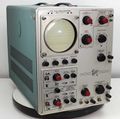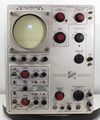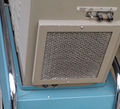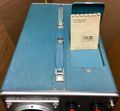531: Difference between revisions
No edit summary |
No edit summary |
||
| Line 13: | Line 13: | ||
}} | }} | ||
The '''Tektronix Type 531''' is a 10 MHz oscilloscope that accepts [[letter-series and 1-series plug-ins]]. It is exactly like Type [[535]] except it does not have the Delayed Sweep (dual timebase) feature. | The '''Tektronix Type 531''' is a 10 MHz oscilloscope that accepts [[letter-series and 1-series plug-ins]]. | ||
It is exactly like Type [[535]] except it does not have the Delayed Sweep (dual timebase) feature. | |||
The 531 and 535 were the first Tektronix scopes to accept plug-ins. | The 531 and 535 were the first Tektronix scopes to accept plug-ins. | ||
It was [[introduced in 1954|introduced in March 1954]] simultaneously with the Type 535, and [[introduced in 1959|superseded in 1959]] by the Type 531A, | It was [[introduced in 1954|introduced in March 1954]] simultaneously with the Type 535, | ||
and [[introduced in 1959|superseded in 1959]] by the Type 531A, | |||
which has more convenient controls and a slightly faster (15 MHz) vertical amplifier. | which has more convenient controls and a slightly faster (15 MHz) vertical amplifier. | ||
| Line 22: | Line 24: | ||
In serial numbers 101 to 7600, the 531's L-C [[delay line]] is before the vertical amplifier. | In serial numbers 101 to 7600, the 531's L-C [[delay line]] is before the vertical amplifier. | ||
In serial numbers 7601 and up, the 531's delay line is between the vertical amplifier and the CRT. | In serial numbers 7601 and up, the 531's delay line is between the vertical amplifier and the CRT. | ||
This change was the result of [[John Kobbe]]'s insight that if the far end of the delay line was an open circuit (which the CRT approximates), | |||
the reflected wave could be absorbed at the source end. | |||
This "single termination" approach made it possible to do away with the output chassis. | |||
All Tek scopes using a lumped-constant delay line went to this topology. | |||
There is also a rack-mount version, Types RM31 and RM31A. | There is also a rack-mount version, Types RM31 and RM31A. | ||
They have a sliding chassis so that the scope can be serviced without removing it from a rack. | |||
The [[532]] is similar to the 531, but designed to be more reliable at the expense of slower risetime. | The [[532]] is similar to the 531, but designed to be more reliable at the expense of slower risetime. | ||
The [[541]] is mostly the same as the 531, but has a [[distributed amplifier|distributed vertical amplifier]] and a different CRT. | |||
==Specifications== | ==Specifications== | ||
| Line 35: | Line 43: | ||
<gallery> | <gallery> | ||
Tek 531a g front.jpg | Tek 531a g front.jpg | ||
531_early_1.jpg | early 531 | |||
rm31a.jpg | RM31A | |||
Tek 531a on cart.JPG | 531A on cart | |||
Tek 531a 34 pr.jpg | 531A | |||
Tek 531a front.jpg | 531A | |||
Tek 531a right top.jpg | 531A | |||
Tek 531a right2.jpg | 531A | |||
Tek 531a right 3.jpg | 531A | |||
Tek 531a right.jpg | 531A | |||
Tek 531a left close.jpg | 531A | |||
Tek 531a left.jpg | 531A | |||
Tek 531 brown 1.jpg | Brown-era 531 with [[CA|Type CA]] | |||
Tek 531 brown 2.jpg | Brown-era 531 with [[CA|Type CA]] | |||
Tek 531 brown 3.jpg | Brown-era 531 Rear | |||
Tek 531a on cart.jpg|531A on cart | |||
Tek 531a manual compartment.jpg | Tek 531a manual compartment.jpg | ||
</gallery> | </gallery> | ||
[[Category:500 series scopes]] | [[Category:500 series scopes]] | ||
Revision as of 15:11, 3 February 2018
The Tektronix Type 531 is a 10 MHz oscilloscope that accepts letter-series and 1-series plug-ins.
It is exactly like Type 535 except it does not have the Delayed Sweep (dual timebase) feature.
The 531 and 535 were the first Tektronix scopes to accept plug-ins. It was introduced in March 1954 simultaneously with the Type 535, and superseded in 1959 by the Type 531A, which has more convenient controls and a slightly faster (15 MHz) vertical amplifier.
531s with below S/N 7950 have DuMont 5BGP2 instead of Tektronix T533P2.
In serial numbers 101 to 7600, the 531's L-C delay line is before the vertical amplifier. In serial numbers 7601 and up, the 531's delay line is between the vertical amplifier and the CRT. This change was the result of John Kobbe's insight that if the far end of the delay line was an open circuit (which the CRT approximates), the reflected wave could be absorbed at the source end. This "single termination" approach made it possible to do away with the output chassis. All Tek scopes using a lumped-constant delay line went to this topology.
There is also a rack-mount version, Types RM31 and RM31A. They have a sliding chassis so that the scope can be serviced without removing it from a rack.
The 532 is similar to the 531, but designed to be more reliable at the expense of slower risetime. The 541 is mostly the same as the 531, but has a distributed vertical amplifier and a different CRT.
Specifications
please add

















